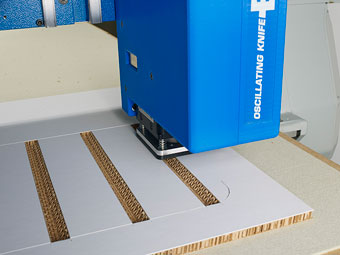Sign-making companies that turn out custom work for clients are now benefitting from the use of programmable CNC (computer numerical control) routers. This technology is operator-friendly and offers cost-effective ways to maximize productivity, making it ideal even for smaller sign shops, where manpower levels may be an issue.
Due to the wide variation in types of companies that turn out signage, it is difficult to put a percentage on how many sign makers have opted for CNC technology. However it is safe to assume the number is well below fifty percent.
Companies that produce high-quality indoor or outdoor signage that demands accurate reproduction from the original design with intricate graphics and are made from durable materials that also makes tolerances harder to hold are ideal candidates for manufacturing via CNC equipment. It’s also a matter of repeatability when producing more than one piece with the same design.
With the required materials becoming more costly all the time, CNC routers can help reduce scrap rates by getting it right on the first pass: cutting simulations (provided by the software) provide a digital rendering of the cut product allowing toolpath adjustments before any material gets cut. Scrap materials mean money coming right out of the sign shop owner’s pocket.
Additionally CNC router technology enables increased production, which has a direct impact on the bottom line.
Consider this example: an entry-level CNC router suitable for the industry may cost $40,000 or more including the CNC table, a vacuum “hold down” system, and an operator-friendly software program. For a smaller sign shop that may have two or three employees manning the equipment, payback on that investment may occur in as little as two years with an entry-level CNC router.
Using the Right Cutting Tools
Sign shops are willing to consider CNC routers with one very good reason at the top of the list: digitally-rendered designs make it easier to create a CNC program that cuts using traditional router bits for harder materials and tangential knives for softer ones like foam-core (which router bits tend to “grab”).
PVC, acrylic, aluminum, and composites are just some of the sign making materials suitable for today’s CNC routers.
Creasing wheels fitted to the tangential knife are another option that can be implemented in cardboard products to create fold lines without creating cuts.
Programmable CNC routers can cut materials between a few thousands of an inch and two inches in thickness.
For non-digitized designs, CNC router technology can scan a product using a laser pointer to create a router path after assigning digital points for each feature.
The leap from traditional sign making software to programs used by CNC routers is not a long one and eases the transition for operators.
Learning the capabilities of the software is 70 percent of the learning curve and reputable suppliers of CNC equipment should supply the initial requisite training needed, in less than a week on average.
CNC Routers are Now More Reliable
The quality and durability of the typical CNC router has never been better, as it also adapts for usage in different sectors of the manufacturing industry.
In the sign business, the more robust construction overall means decreased regular maintenance, increased flexibility, and more cost-effective production.
For example, it is very unlikely that the servo motors driving the motion of the router would need to be replaced during the lifespan of the machine. Stable power supply within the shop helps protect the electronic circuitry.
Additionally a helical gear rack and pinion system allows more power to be driven into the gears and creates a smoother motion and more efficient material cutting. That means increased accuracy and tighter tolerances.
Selecting the proper tool for the material to be cut is often the operator’s toughest task. That is why proper training at the time of installation and a database that cross-references materials and appropriate tooling is key to any shop’s success.
Is it Time to Consider a CNC router?
The Sign Bros., a four-man sign shop in Athens, Georgia, invested in a CNC router when they realized how much money they were spending to outsource work.
Their business has grown considerably in the four years since making that upgrade. Much of that growth is a direct result of increased speed of production, the ability to create signs on-site, and the addition of new configurations that weren’t possible when outsourcing jobs.
A CNC router was “the best purchase we ever made as a sign company,” says co-owner Justin Seibert. “Now we [can] route shapes and letters for all kinds of dimensional signage.”
For about the annual cost of one experienced employee, companies can invest in a reliable, operator-friendly technology that will be on the job for many years to come.
By Chris Montouchet, a U.S. regional manager for AXYZ International, a global manufacturer of CNC Router and CNC Knife Systems. Call 800/361-3408 or visit axyz.com.
All photos: AXYZ International.











